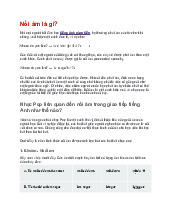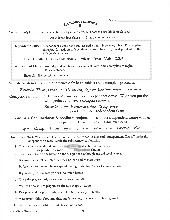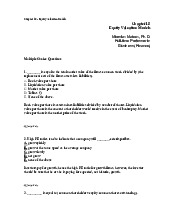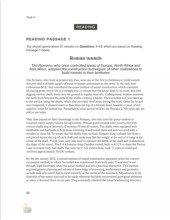













Preview text:
lOMoAR cPSD| 58797173
ĐỀ THI GIỮA HỌC KỲ 1 NĂM HỌC 2020-2021
1. Combine the following set of sentences into a complex sentence
The teacher conducted a discussion period. Jack sat at the desk with his head down.
He did not want the teacher to call on him. He had not read the assignment.
2. Explain the ambiguity in the following sentences:
a. They are encouraging reports
b. John floated the boat between the rocks.
3. Draw the two possible tree diagrams for the following sentence:
John floated the boat between the rocks.
4. Identify the class and function of non-finite clauses in the following sentences
a. He moved his chair to be closer to her.
b. An official declared the place to be free from infection. C. He urged his friend to give up drug.
d. He found it interesting to read this book.
e. He noticed the child entering the court.
5. Identify the verbs and Write down the patterns of the following sentences.
The following terms can be used with reference to verbs: a. intensive c. stative e intransitive g ditransitive
b. extensive d dynamic f. monotransitive h complex transitive
1. The bowler threw the ball at the slumps.
2. The jury found the prisoner guilty.
3. The performance lasted three hours unfortunately.
4. The farmer was eating his lunch in the cornfield.
5. The transport manager could not decide on a new bus. NĂM HỌC 2020-2021 lOMoAR cPSD| 58797173
1. Combine the following set of sentences into a complex sentence
Louse used a dandruff shampoo. She still had dandruff. dermatologist. She decided to see a dermatologist.
2. Explain the ambiguity in the following sentences:
a. They gave me the late summer's roses.
b. The students complained to everyone that they could understand.
3. Draw the two possible tree diagrams for the following sentence:
The students complained to everyone that they couldn't understand.
4 . Identify the class and function of non-finite clauses in the following sentences
a. To be eligible for a scholarship, you have to be a permanent student.
b. They are considering the question to be debated in the Parliament.
c. Consumed by guilt, he confessed to the crime.
d. It is hard to know where to turn for advice.
e. They are reluctant for the news to be made public.
5. Identify the verbs and Write down the patterns of the following sentences.
The following terms can be used with reference to verbs: a. intensive c. stative e intransitive g ditransitive
b. extensive d dynamic f. monotransitive h complex transitive
1. We found the wall overgrown with ivy.
2. Jim passed the salt down the table.
3. He didn't lend the new model car to the child in his class.
4. The vehicle is moving slowing along the streets due to traffic jam.
5. The driver in the car seepts to be very annoyed. NĂM HỌC 2020-2021
1. Combine the following set of sentences into a complex sentence lOMoAR cPSD| 58797173
Vincent Van Gogh was born in Holland in 1853. He is one of the world's most
famous painters. His talent was unrecognized throughout his life. It was much appreciated after his death
2. Explain the ambiguity in the following sentences:
a. This is my father's photograph
b. He showed me that greasy kid stuff.
3. Draw the tree diagram for the following sentence:
He showed me that greasy kid stuft.
4. Identify the class and function of non-finite clauses in the following sentences
a. The Food and Drug Administration will allow food manufacturers to label certain foods.
b. He found it difficult to cross the river.
c. Tony is struggling to succeed.
d. We ate early, being excessively hungry.
e. Is this the chair to sit on?
5. Identify the verbs and Write down the patterns of the following sentences.
following terms can be used with reference to verbs: a intensive c. stative e intransitive g ditransitive b. extensive d dynamic
f. monotransitive h complex transition
1. Gordon sent his apologies to the meeting.
2. The old fellow forgot about Jim yesterday.
3. Your Madras curry smells appetizing.
4. The children played in the garden all yesterday afternoon.
5. All of them called Harry a fine fellow.
HỌC KỲ I, NĂM HỌC 2016 - 2017
1. Combine the following set of sentences into a complex sentence lOMoAR cPSD| 58797173
Ed skimmed through the help-wanted ads. Nothing was there for him. He
desperately needed a job. He would have to sell his car. He could no longer keep up the payments.
2. Explain the ambiguity in the following sentences:
a. I saw him walking by the bank.
b. He was carrying a woman's coat on his arm.
3. Draw the two possible tree diagrams for the following sentence:
I saw him walking by the bank.
4. Identify the class and function of non-finite clauses in the following sentences
a. One of them even reported his having been seen off the coast of the British Zoneon a red yacht.
b. New York City's budget crisis appeared to have been settled.
c. We were pleased to be seeing our old friends,
d. He is very busy learning for the next test.
e. The reporter pressed her to answer his questions.
5. Identify the verbs and Write down the patterns of the following sentences.
The following terms can be used with reference to verbs: a. intensive c. stative e intransitive g ditransitive
b. extensive d dynamic f. monotransitive h complex transitive
1. The committee considers your proposals rather unworkable.
2. The delinquent received a reprimand from the magistrate. 3. The milk has gone sour.
4. Barry sent Mary a bunch of carnations.
5. You must not walk on the grass SYNTAX TEST
Question 1: Identify the class and function of the non-finite clauses in the
sentences below (2.5ms):
a. She's got one or two bugs named after her. lOMoAR cPSD| 58797173
b. it was necessary to allow the cow freedom to move during the operation
c. What a way to end the game!
d.Helen tells jokes to make people smile.
e. Don't forget to put out fresh food and water for the dog
Question 2: Combine the following set of sentences into one complex sentence
It was a dark and stormy night. The wind was high. I looked around me and saw
that I wasn't alone. A man stood behind me. He was tall. He was mean. He had a knife.
Question 3: The following sentence is ambiguous (2ms) To
speak the truth frankly is an unsafe policy
(a) Draw the two possible structures
(b) Explain what the two readings are.
(c) Which reading corresponds to which structure?
Question 4: Identify the verbs and the patterns of the following sentences. The
following terms can be used with reference to verbs. (2.5ms) a. intensive c. stative e intransitive g ditransitive
b. extensive d dynamic f. monotransitive h complex transitive
1. The personality test found Henry unsuitable for the position 2. He looked over the table
3. The milk turned sour after 2 days.
4. My brother showed me how to operate the machine.
5. She turned up at the party although she wasn’t invited.
Question 5: Decide whether the underlined strings of words are constituents
or not. Give your explanation. (1.5ms)
a. Humpty Dumpty washed himself with soapy water.
b. The greedy mouse devoured the cheese in the tower.
c. The Cheshire Cat dislikes grey mice with pink tails.
d. The Mad Hatter will give some herbal tea to Alice lOMoAR cPSD| 58797173
e. Humpty Dumpty and the Cheshire Cat never eat together. SYNTAX 1.
1. Identify the class and function of the non-finite clauses in the sentences below.
a. He moved his chair to be closer to her.
b. An official declared the place to be free from infection.
c. He urged his friend to give up drug.
d. He found it interesting to read this book.
e. It disturbed me to see so many people wasting their time.
2. Read the following sentences:
a. He saw many dead men riding across the battlefield
b. There is no smoking section available.
If you think they are ambiguous, explain the different meanings.
3. Draw two possible tree diagrams for the following sentence.
He saw many dead men riding across the battlefield.
4. Combine the following set of sentences into one complex sentence.
Michelangelo studied anatomy. He dissected cadavers. Such gruesome work
helped him understand human bones and muscles. His sculpture celebrates the human body.
5. Identify the verbs and the patterns of the following sentences. The
followingterms can be used with reference to verbs: a. intensive c. stative e intransitive g ditransitive
b. extensive d dynamic f. monotransitive h complex transitive
1. Maybelle looked impatiently at her watch.
2. The luggage weighed 20 kilos.
3. Surprisingly, the diners at the expensive restaurant found their entrees tasteless. lOMoAR cPSD| 58797173
4. His mother called up the stairs.
5. Holdenfis writing a letter to the White House. SYNTAX 2.
1. Identify the class and function of the non-finite clauses in the sentences below.
a. She answers it keeping silent.
b. The runner drank a bottle of water to cool his parched throat.
c. His father forced him to tell the truth
d. He is an excellent student to speak English well.
e. The extra money helped John to be independent.
2. Read the following sentences:
a. He stood watching the fireworks in the backyard. b. I read the letter to Fred.
If you think they are ambiguous, explain the different meanings.
3. Draw two possible tree diagrams for the following sentence.
He stood watching the fireworks in the backyard.
4. Combine the following set of sentences into one complex sentence.
Vincent Van Gogh was born in Holland in 1853. He is one of the world's most
famous painters. His talent was unrecognized throughout his life. It was much appreciated after his death.
5. Identify the verbs and the patterns of the following sentences. The
followingterms can be used with reference to verbs: a. intensive c. stative e intransitive g ditransitive
b. extensive d dynamic f. monotransitive h complex transitive
1. Upon his return, the people elected Jasper king of the entire country.
2. Because it’s very hot, trees keen motionless.
3. The kite soared through the air lOMoAR cPSD| 58797173
4. He can't order me to jump into the river.
5. You must return that overdue book to the library tomorrow morning. SYNTAX 3.
1. Identify the class and function of the non-finite clauses in the sentences below.
a. There are only two people to answer the phone today.
b. Her hair blowing in the wind, she drove the convertible around the block.
c. It is hard to know where to turn for a drive.
d. Whose idea was it to give a party?
e. We considered this matter to have been settled years ago
2. Read the following sentences:
a. Two cars were reported stolen by the Groveton police yesterday
b. The matron fed her dog biscuits.
If you think they are ambiguous, explain the different meanings.
3. Draw two possible tree diagrams for the following sentence.
Two cars were reported stolen by the Groveton police yesterday
4. Combine the following set of sentences into one complex sentence.
The first documented case of AIDS within the United States occurred in 1977. The
AIDS crisis continues to grow. The number of newspaper and magazine articles on
AIDS has declined in the last few years.
5. Identify the verbs and the patterns of the following sentences. The
followingterms can be used with reference to verbs: a. intensive c. stative e intransitive g ditransitive
b. extensive d dynamic f. monotransitive h complex transitive
1. In spite of all the commercialism, Christmas remains my favorite time of year.
2. I have to appear in court on a charge of drunken driving. lOMoAR cPSD| 58797173
3. Granny left Gary all of her money.
4 The class picked Susia class representative
5. I came into an old book while looking for my glasses SYNTAX 4.
1. Identify the class and function of the non-finite clauses in the sentences below.
a. The treasure remained buried in the secret vault
b. He is afraid to strike out on his own.
c. The heirs didn't know about the money hidden in the Swiss bank account.
d. They arrived home finding that the house had been burgled.
e. It is impossible to reach the top of the mountain in the severe weather.
2. Read the following sentences:
a. It is not advisable to take aspirin and alcohol after a meal
b. That sheepdog is too hairy to eat.
If you think they are ambiguous, explain the different meanings.
3. Draw two possible tree diagrams for the following sentence. It is not
advisable to take aspirin and alcohol after a meal
4. Combine the following set of sentences into one complex sentence.
The fans wait in line to buy tickets. The fans often pay more than $5 dollars for a
ticket, The fans are unhappy about the ticket prices. The fans love Peter.
5. Identify the verbs and the patterns of the following sentences. The
followingterms can be used with reference to verbs. a. intensive c. stative e intransitive g ditransitive
b. extensive d dynamic f. monotransitive h complex transitive
1. The teacher thought him stupid.
2. Santa flies through the air in a sleigh pulled by eight tiny reindeer. lOMoAR cPSD| 58797173
3. The devont fews of Philadelphia built themselves a very heautiful synagogue in 1770.
4. In spite of all the commercialism, Christmas remains my favorite time of year5.
Ho looked over the tabic whilc scarching the house. SYNTAX 5.
1. Identify the class and function of the non-finite clauses in the sentences below.
a. Bob believes Besty to be beautiful
b. He found it annoying to see many people wasting their time
c. The girl sitting in the corner was reading an interesting book.
d. He didn't envisage there being any danger.
e. All men are liars, roughly speaking.
2. Read the following sentences:
a. To speak the truth frankly is an unsafe policy.
b. He found smoking grass annoying.
If you think they are ambiguous, explain the different meanings.
3. Draw two possible tree diagrams for the following sentence.
To speak the truth frankly is an unsafe policy.
4. Combine the following set of sentences into onc complex sentences.
Mark Twain is the author of Huckleberry Finn. Huckleberry Finn is a classic
American novel. Mark Twain's real name was Samuel L. Clemens. He lived in Hartford several years.
5. Identify the verbs and the patterns of the following sentences. The
followingterms can be used with reference to verbs: a. intensive c. stative e intransitive g ditransitive
b. extensive d dynamic f. monotransitive h complex transitive lOMoAR cPSD| 58797173
1. Your luggage weights seventy kilos.
2. They rolled the barrel, into the courtyard
3. The children grow up under their grandparents’ upbringing.
4. We imagined Uncle John much older.
5. Gocdon send his apologies to the meeting SYNTAX 6. (2013-2014)
1. Identify the class and function of the non-finite clauses in the sentences below.
a. To be eligible for a scholarship, you have to be a permanent student.
b. They are considering the question to be debated in the Parliament.
2. Read the following sentences:
a. They gave me the late summer's roses.
b. The students complained to everyone that they couldn't understand.
If you think they are ambiguous, explain the different meanings.
3. Draw two possible tree diagrams for the following sentence.
The students complained to everyone that they couldn't understand,
4. Combine the following set of sentences into one complex sentence.
Louse used a dandruff shampoo. She still had dandruff. She decided to see a dermatologist.
5. Identify the verbs and the patterns of the following sentences. The
followingterms can be used with reference to verbs. a. intensive c. stative e intransitive g ditransitive
b. extensive d dynamic f. monotransitive h complex transitive
1. We found the wall overgrown with ivy
2. Jim passed the salt down the table.
3. He didn't lend the new model car to the child in his class. lOMoAR cPSD| 58797173
4. The vehicle is moving slowing along the streets due to the traffic jam.
5. The driver in the car seems to be very annoyed.
a. By using a participle: to reduce an adverb/adjective clause ( Tĩnh lược mđ chỉ nguyên nhân)
The boy was tired of playing. He sat down to rest.
→ (Being) tired of playing, the boy sat down to rest.( simple sentence)
Because the boy was tired of playing, he sat down to rest. ( complex sentence)
Ex: 1. A crow stole a piece of cheese. She flew to her nest to enjoy the tasty meal.
->> Stealing a piece of cheese, a crow flew to her nest to enjoy the tasty meal.
Having stolen a piece of cheese, she…………………
2. A hungry fox saw some bunches of grapes. They were hanging from a vine.
->> A hungry fox saw some bunches of grapes, haging from a vine
3. The letter was badly written. I had great difficulty in making out its contents.
->> I had great difficulty in making out contents of the letter badly written
4. John lost the favour of his boss. He was dismissed from his high offices.
->> Loosing the favour of his boss, he was dismissed from his high offices.
5. The old man was walking lonely on a quiet road. He saw a little girl beside a tree. She
was crying loudly. She looked very poor.
->> While The old man was walking lonely on a quiet road. . He saw a poor little girl crying loudly beside a tree.
>> Walking lonely on a quite road, the old man saw a little poor girl crying loudly beside a tree.
b. By using a noun or a phrase in apposition: ( A noun placed right after the
noun it refer to) ( gthich cho N đi trc,
This town was once a prosperous sea-port. It is now a heap of ruins.. - >>
1. Tom's uncle is a millionaire. He sent him to England for his education.
->> Tom's uncle, a millionaire, sent him to England for his education
2. One of the most famous works of Shakespeare is Romeo and Juliet. It is atragedy.
->> One of the most famous works of Shakespeare, Romeo and Juliet, is a tragedy. lOMoAR cPSD| 58797173
3. De Lesseps built the Suez Canal. This was a great project. He was a Frenchengineer.
->> De Lesseps, a French engineer, built a great project, the Suez Canal.
4. We saw a beautiful picture. It is a world-famous masterpiece. The
picturewas displayed in the National Art Gallery.
->> We saw a beautiful picture, a world-famous masterpiece, displayed in the National Art Gallery.
5. Dr Hillary was elected President of the company. She was a well-known
politician of the Liberal Party.
->> . Dr Hillary, was a well-known politician of the Liberal Party, was elected President of the company
c. By using a nominative absolute construction: NP + Participle phrase ( used to
reduce adverb clauses when they have subjects different from those of main clause)
1. It was a very hot day. I could not do my work satisfactorily. The day being very hot, I
could not do my work satisfactorily.
2. His house has been burned down in a terrible fire. He lives in a hotel.
. His house burned down in a terrible fire. He lives in a hotel.
3. The holidays are at an end. Boys are returning to school.The holidays being at an end. Boys are returning to school.
4. The secretaryship was vacant. Nobody was willing to undertake the post. I applied for it.
The secretaryship being vacant and nobody being willing to apply for the post, I applied for it
5. The teacher was out of the room. The door was shut. The students made a lot of noise.
d. By using a preposition + a noun/gerund:
1. The man has a good record. It is impossible to suspect such a man.
It is impossible to suspect such a man who has/having/with a good record
2. There was a shortage of food and water. The explorers could not go any farther.
Because of a shortage of food and water , the explorers could not go any farther.
3. He made heroic effort to succeed. He failed.
In spite of making heroic effort to succeed, he failed.
4. I have examined the report. I found many errors in it.
After having examined the report, I found many errors in it.
After the examination of the report, I found many errors in it.
5. She stood there for hours. She did not move. She did not speak.
e. By using an infinitive: purpose/adjective as postmodifier of a NP/too/enough
1. He cannot afford a car. He is too poor. lOMoAR cPSD| 58797173
He is too poor to affort a car.
2. The strikers held a meeting. They wanted to discuss the terms of the employers.
The strikers held a meeting to to discuss the terms of the employers.
3. He must apologise. He will not escape punishment otherwise. He must apologise to escape punishment.
4. I have told you all. There is nothing more to be said. I have nothing more to tell you.
5. He keeps some fierce dogs. They will guard his house. They will keep away robbers.
He keeps some fierce dogs to guard his house and keep away robbers.
f. By using an adverb (phrase):
1. He has succeeded. His success has been beyond my expectations. He has succeeded beyond my expectations.
2. The boy was obstinate. He refused to listen to advice.
The boy obstinatly refused to listen to advice.
3. These men worked very hard. They deserved to succeed. They failed.
Working very hard to succeed deservedly, these men failed
4. Boys grow up to be men. The growth is very slow. It cannot be seen.
Boy grow up to be men slowly and invisibly.
5. He admitted his errors. He expressed his regret.
He admitted his errors with regretly
g. By using the combination of several methods
4. Combination of two or more simple sentences into a single complex sentence:
Complex sentence= 1 Main clause +1 or more finite subordinate clauses( Noun
clause/ Adj clause? Adverb clause) Page 89



